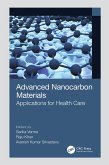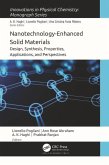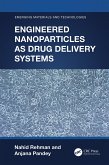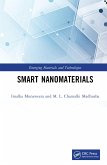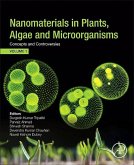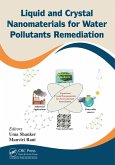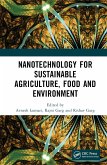The Science of Nanomaterials
Basics and Applications
Herausgeber: Ameta, Rakshit; Ameta, Suresh C.
The Science of Nanomaterials
Basics and Applications
Herausgeber: Ameta, Rakshit; Ameta, Suresh C.
- Gebundenes Buch
- Merkliste
- Auf die Merkliste
- Bewerten Bewerten
- Teilen
- Produkt teilen
- Produkterinnerung
- Produkterinnerung
Covers the important aspects of nanomaterials by focusing on the many issues related to food and textile industries, treatment of polluted water, health, energy crises, targeted drug delivery, etc.
Andere Kunden interessierten sich auch für
![Advanced Nanocarbon Materials Advanced Nanocarbon Materials]() Advanced Nanocarbon Materials147,99 €
Advanced Nanocarbon Materials147,99 €![Nanotechnology-Enhanced Solid Materials Nanotechnology-Enhanced Solid Materials]() Nanotechnology-Enhanced Solid Materials174,99 €
Nanotechnology-Enhanced Solid Materials174,99 €![Engineered Nanoparticles as Drug Delivery Systems Engineered Nanoparticles as Drug Delivery Systems]() Nahid RehmanEngineered Nanoparticles as Drug Delivery Systems97,99 €
Nahid RehmanEngineered Nanoparticles as Drug Delivery Systems97,99 €![Smart Nanomaterials Smart Nanomaterials]() Imalka MunaweeraSmart Nanomaterials105,99 €
Imalka MunaweeraSmart Nanomaterials105,99 €![Nanomaterials in Plants, Algae, and Microorganisms Nanomaterials in Plants, Algae, and Microorganisms]() Nanomaterials in Plants, Algae, and Microorganisms195,99 €
Nanomaterials in Plants, Algae, and Microorganisms195,99 €![Liquid and Crystal Nanomaterials for Water Pollutants Remediation Liquid and Crystal Nanomaterials for Water Pollutants Remediation]() Liquid and Crystal Nanomaterials for Water Pollutants Remediation184,99 €
Liquid and Crystal Nanomaterials for Water Pollutants Remediation184,99 €![Nanotechnology for Sustainable Agriculture, Food and Environment Nanotechnology for Sustainable Agriculture, Food and Environment]() Nanotechnology for Sustainable Agriculture, Food and Environment132,99 €
Nanotechnology for Sustainable Agriculture, Food and Environment132,99 €-
-
-
Covers the important aspects of nanomaterials by focusing on the many issues related to food and textile industries, treatment of polluted water, health, energy crises, targeted drug delivery, etc.
Hinweis: Dieser Artikel kann nur an eine deutsche Lieferadresse ausgeliefert werden.
Hinweis: Dieser Artikel kann nur an eine deutsche Lieferadresse ausgeliefert werden.
Produktdetails
- Produktdetails
- Verlag: Apple Academic Press Inc.
- Seitenzahl: 378
- Erscheinungstermin: 29. Dezember 2022
- Englisch
- Abmessung: 165mm x 241mm x 26mm
- Gewicht: 832g
- ISBN-13: 9781774910726
- ISBN-10: 1774910721
- Artikelnr.: 66269565
- Herstellerkennzeichnung
- Libri GmbH
- Europaallee 1
- 36244 Bad Hersfeld
- gpsr@libri.de
- Verlag: Apple Academic Press Inc.
- Seitenzahl: 378
- Erscheinungstermin: 29. Dezember 2022
- Englisch
- Abmessung: 165mm x 241mm x 26mm
- Gewicht: 832g
- ISBN-13: 9781774910726
- ISBN-10: 1774910721
- Artikelnr.: 66269565
- Herstellerkennzeichnung
- Libri GmbH
- Europaallee 1
- 36244 Bad Hersfeld
- gpsr@libri.de
Suresh C. Ameta, PhD, is currently Professor of Eminence and Former Dean, Faculty of Science at PAHER University, Udaipur, India. He has served as Professor and Head of the Department of Chemistry at North Gujarat University Patan and at M. L. Sukhadia University, Udaipur, and as Head of the Department of Polymer Science. He also served as Dean of Postgraduate Studies. Prof. Ameta has held the position of President of the Indian Chemical Society, Kotkata, and is now a life-long Vice President. He was awarded a number of prestigious awards during his career, such as national prizes twice for writing chemistry books in Hindi. He also received the Prof. M. N. Desai Award (2004), the Prof. W. U. Malik Award (2008), the National Teacher Award (2011), the Prof. G. V. Bakore Award (2007), a Life-Time Achievement Award by the Indian Chemical Society (2011) as well as the Indian Council of Chemist (2015), etc. Having more than 350 research publications to his credit in journals of national and international repute, he is also the author of many undergraduate- and postgraduate-level books. He has published three books with Apple Academic Press: Chemical Applications of Symmetry and Group Theory; Microwave-Assisted Organic Synthesis; and Green Chemistry: Fundamentals and Applications; and two with Taylor and Francis: Solar Energy Conversion and Storage and Photocatalysis. He has also written chapters in books published by several other international publishers. Prof. Ameta has delivered lectures and chaired sessions at national conferences and is a reviewer of number of international journals. In addition, he has completed major research projects for different funding agencies, such as DST, UGC, CSIR, and Ministry of Energy, Govt. of India. Rakshit Ameta, PhD, is Associate Professor of Chemistry, J. R. N. Rajasthan Vidyapeeth University, India. He has several years of experience in teaching and research in chemistry as well as industrial chemistry and polymer science. He is presently guiding six research students for their PhD theses, and eight students have already obtained their PhDs under his supervision in green chemistry. Dr. Rakshit Ameta has received various awards and recognition in his career, including being awarded first position and the gold medal for his MSc and receiving the Fateh Singh Award from the Maharana Mewar Foundation, Udaipur, for his meritorious performance. He has served at M. L. Sukhadia University, Udaipur; the University of Kota, Kota; and PAHER University, Udaipur. He has over 100 research publications to his credit in journals of national and international repute. He holds one patent, and two more are under way. Dr. Rakshit has organized several national conferences as Organizing Secretary at the University of Kota and PAHER University. He has delivered invited lectures and has chaired sessions in conferences held by the Indian Chemical Society and the Indian Council of Chemists. Dr. Rakshit was elected as council member of the Indian Chemical Society, Kolkata, and council member and zonal secretary, the Indian Council of Chemists, Agra, as well as Associate Editor, Physical Chemistry Section of Indian Chemical Society. Dr. Rakshit has also worked as Scientist-in-Charge in the Industrial and Applied Chemistry Section of the Indian Chemical Society. He has written five degree-level books and has contributed chapters to books published by several international publishers. He has published three books with Apple Academic Press: Chemical Applications of Symmetry and Group Theory; Microwave-Assisted Organic Synthesis; and Green Chemistry: Fundamentals and Applications; and two with Taylor and Francis: Solar Energy Conversion and Storage and Photocatalysis. His research areas focus on wastewater treatment, photochemistry, green chemistry, microwaveassisted reactions, environmental chemistry, nanochemistry, solar cells, and bioactive and conducting polymers.
1. Nanomaterials: An Introduction 2. Optical Properties of Nanostructured
Materials and Their Sensing Applications 3. Nanotechnology for Selective
Targeting and Cancer Drug Delivery 4. Cogent and Strategic Approaches for
Gene Delivery with Nanostructures 5. Nanomaterials for Nanomedical and
Nanobiotechnological Studies: Current Status and Applications of
Carbon-Based Nanomaterials and Quantum Dots 6. Carbon Nanotubes for
Photosplitting of Water 7. Nanomaterials as Effective Tools for Detection
and Microbial Diagnosis of Foodborne Pathogens 8. Use of Nanomaterials in
Wastewater Treatment 9. Layer-by-Layer Assembly as a Powerful
Nanofabrication Technique for the Design of Antimicrobial Surfaces in the
Textile Industry 10. Prospect of Utilizing Novel Nanomaterials for
Effective Food Security, Safety, Packaging, and Preservation 11. Bio- and
Synthetic Nanocomposites for Food Packaging 12. Fabrication and
Applications of Nanocomposites
Materials and Their Sensing Applications 3. Nanotechnology for Selective
Targeting and Cancer Drug Delivery 4. Cogent and Strategic Approaches for
Gene Delivery with Nanostructures 5. Nanomaterials for Nanomedical and
Nanobiotechnological Studies: Current Status and Applications of
Carbon-Based Nanomaterials and Quantum Dots 6. Carbon Nanotubes for
Photosplitting of Water 7. Nanomaterials as Effective Tools for Detection
and Microbial Diagnosis of Foodborne Pathogens 8. Use of Nanomaterials in
Wastewater Treatment 9. Layer-by-Layer Assembly as a Powerful
Nanofabrication Technique for the Design of Antimicrobial Surfaces in the
Textile Industry 10. Prospect of Utilizing Novel Nanomaterials for
Effective Food Security, Safety, Packaging, and Preservation 11. Bio- and
Synthetic Nanocomposites for Food Packaging 12. Fabrication and
Applications of Nanocomposites
1. Nanomaterials: An Introduction 2. Optical Properties of Nanostructured
Materials and Their Sensing Applications 3. Nanotechnology for Selective
Targeting and Cancer Drug Delivery 4. Cogent and Strategic Approaches for
Gene Delivery with Nanostructures 5. Nanomaterials for Nanomedical and
Nanobiotechnological Studies: Current Status and Applications of
Carbon-Based Nanomaterials and Quantum Dots 6. Carbon Nanotubes for
Photosplitting of Water 7. Nanomaterials as Effective Tools for Detection
and Microbial Diagnosis of Foodborne Pathogens 8. Use of Nanomaterials in
Wastewater Treatment 9. Layer-by-Layer Assembly as a Powerful
Nanofabrication Technique for the Design of Antimicrobial Surfaces in the
Textile Industry 10. Prospect of Utilizing Novel Nanomaterials for
Effective Food Security, Safety, Packaging, and Preservation 11. Bio- and
Synthetic Nanocomposites for Food Packaging 12. Fabrication and
Applications of Nanocomposites
Materials and Their Sensing Applications 3. Nanotechnology for Selective
Targeting and Cancer Drug Delivery 4. Cogent and Strategic Approaches for
Gene Delivery with Nanostructures 5. Nanomaterials for Nanomedical and
Nanobiotechnological Studies: Current Status and Applications of
Carbon-Based Nanomaterials and Quantum Dots 6. Carbon Nanotubes for
Photosplitting of Water 7. Nanomaterials as Effective Tools for Detection
and Microbial Diagnosis of Foodborne Pathogens 8. Use of Nanomaterials in
Wastewater Treatment 9. Layer-by-Layer Assembly as a Powerful
Nanofabrication Technique for the Design of Antimicrobial Surfaces in the
Textile Industry 10. Prospect of Utilizing Novel Nanomaterials for
Effective Food Security, Safety, Packaging, and Preservation 11. Bio- and
Synthetic Nanocomposites for Food Packaging 12. Fabrication and
Applications of Nanocomposites


